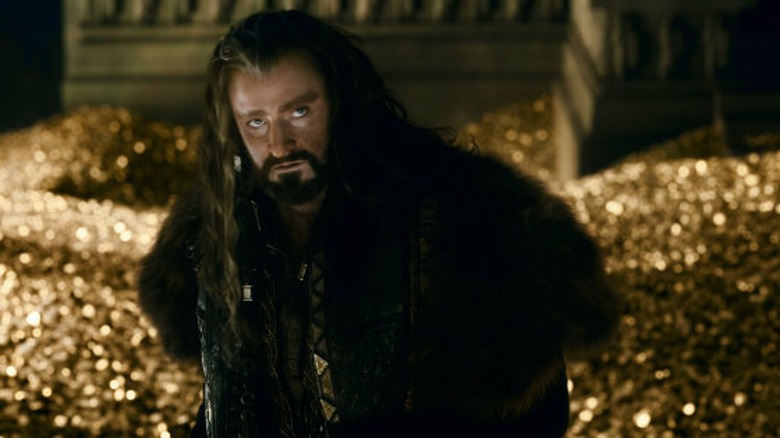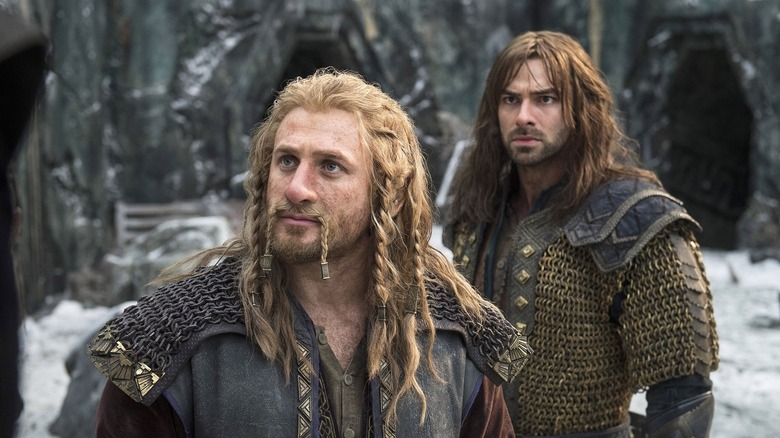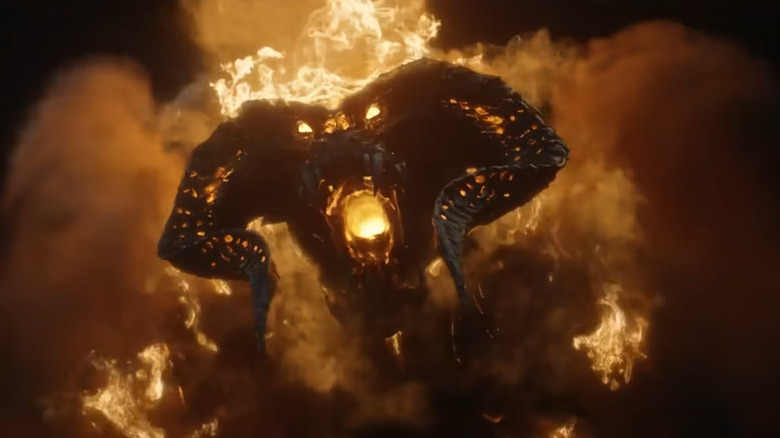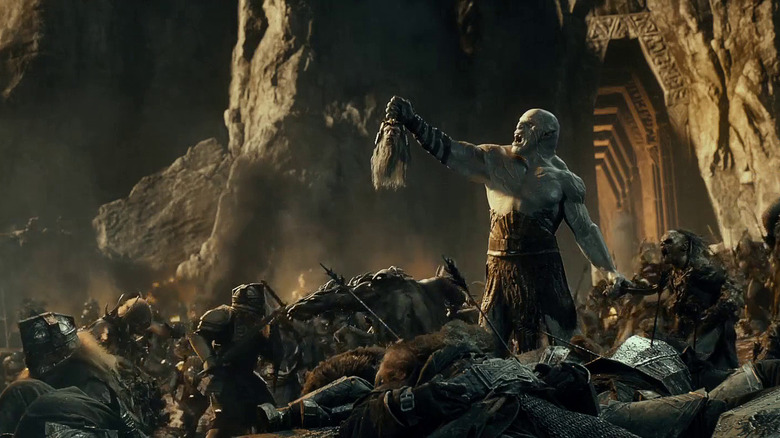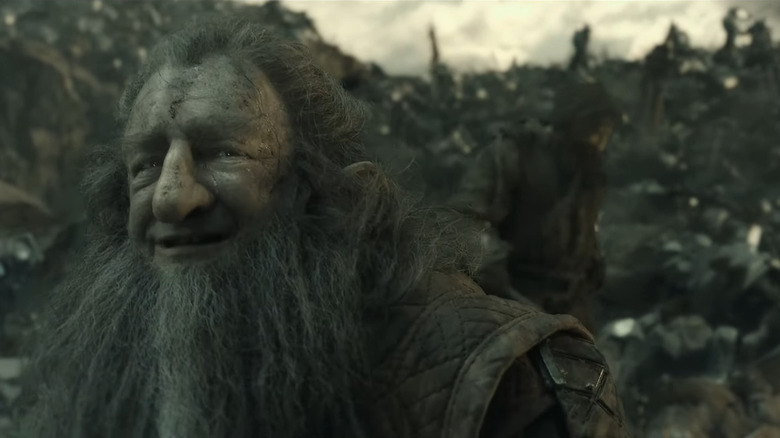The Hobbit's Thorin Had A Burned Dwarf Brother - Here's What That Means
J.R.R. Tolkien is known for his attention to detail. He would develop intricate character backstories and weave complex historical analyses of everything in his world. In fact, that world, in and of itself, only exists "to provide the necessary background of 'history' for Elvish tongues," as the author famously explained in the foreword to "The Fellowship of the Ring."
The Dwarves are one of Tolkien's most mysterious people groups. We know a decent amount about the daily eccentricities and foibles of Thorin and his twelve companions, thanks to "The Hobbit." By and large, the rest of the inwardly-focused race has a long, secret history that only occasionally finds expression in their creator's pen.
Dwarvish origins are unique, their culture and geography are largely unknown, and their women are famously hard to spot. Taken altogether, most of the stories in Middle-earth (written from an Elvish, Mannish, or Hobbitish perspective) don't include the Dwarves very much. And yet, when the little tidbits of Dwarvish storytelling bubble to the surface, they're usually captivating — as is the case with a group of the bearded heroes (including Thorin's own brother, Frerin) who are known as "burned Dwarves."
Finding the Dwarvish details in Middle-earth
Understanding the history of enormously important Dwarves like Thorin is a tricky business. Some details are tucked into the narrative, like when J.R.R. Tolkien describes the Dwarves' behavior when they arrive at Bag End at the beginning of "The Hobbit." He also uses their dialogue to display their lust for gold and precious things. A few scraps of Dwarvish history are included in books like "The Silmarillion" and "Unfinished Tales."
Arguably the most extensive repository for Dwarvish historical data is found in the appendices at the end of "The Return of the King." There, Tolkien spends nearly a dozen pages summarizing the history and misfortunes of Thorin's family and people (i.e., the reason he sets out on the quest of Erebor to reclaim his homeland in "The Hobbit" in the first place).
In that section of the book, we hear about Thorin's father, grandfather, sister, and nephews. We also hear about his brother, Frerin, a Dwarf who is long gone by the time Thorin and his troop pay Bilbo Baggins a visit in the Shire. In fact, Frerin isn't just deceased by that time. He's also been given the unique, rare, and prestigious moniker of being a "burned dwarf" thanks to his heroic sacrifice in one of the biggest battles in Dwarvish history.
The Orcs and Dwarves go to war
To properly understand the concept of a "burned Dwarf" in Middle-earth, we need to back up to a well-known event: the awakening of the Balrog in the mines of Moria. While this happens in the Second Age in Prime Video's "The Rings of Power" series, J.R.R Tolkien originally had the event happen much later — two thousand years into the Third Age, to be precise. When the Balrog wakes up, he does so on the wrong side of the bed. Before long, he drives the Dwarves (Thorin's ancestors) out of their ancestral subterranean mansion.
The homeless group heads north where, among other things, they settle multiple kingdoms, including the Lonely Mountain. They also fight with dragons and, eventually, lose the Lonely Mountain when Smaug shows up on the scene.
After Smaug dispossesses them of their home yet again, the battered and bruised group wanders for a while. Eventually, their king (Thorin's grandfather Thrór) becomes fed up with his people's sorry state and returns to Khazad-dûm with just a single servant by his side. Yeah, no armies, no strategy. Just a solo trip to check out his ancestor's ancient home.
If that sounds kind of nuts, it's because it is. It's a desperate move. At this point, there's no reason to believe the Balrog has left, and it turns out that the place isn't just demon-possessed by this time. It's filled with Orcs, too. The villains kill King Thrór, sparking a conflict called the War of the Dwarves and the Orcs.
The origin of the burned Dwarf
When Thrór is killed during his ill-advised trip to the ruins of Khazad-dûm (which at this point is known as Moria, meaning "the Black Chasm" or "the Black Pit"), it sparks a major conflict between two ancient subterranean rivals: the Orcs and the Dwarves. The War of the Dwarves and Orcs is as hidden as it is massive. For three years, all of the Dwarven houses (a septet of clans descended from the Seven Fathers of the Dwarves) gather together. Once united, they attack the Orcs of the Misty Mountains, systematically rooting them out of every single underground fortress and stronghold that they possess. "The Return of the King" appendices explain the vicious fighting, saying, "Both sides were pitiless, and there was death and cruel deeds by dark and by light."
The war starts in the far north and works its way south through the mountain chain until the Dwarves reach Khazad-dûm itself. There, they fight an epic battle that goes by the delightfully difficult-to-pronounce name of the Battle of Azanulbizar. This final fight is particularly awful, with the book explaining that "at the memory of [the Battle of Azanulbizar] the Orcs still shudder, and the Dwarves weep." The latter are victorious in this fight, but it's a pyrrhic victory, and half of the Dwarves die or are mortally wounded in the fighting — tragically, including Thorin's brother, Frerin. This presents a new problem ... how do the few exhausted Dwarves who remain tend to their dead? In their desperation, the survivors turn to fire.
Burn them. Burn them all...
The appendices to "The Return of the King" explain that, to tend to so many of their dead compatriots, first the Dwarves "stripped all their dead so that Orcs should not come and win there a store of weapons and mail." Shortly after, the text adds, "Then they built many pyres and burned all the bodies of their kin."
At this point, J.R.R. Tolkien includes an important footnote, which reads, "Such dealing with their dead seemed grievous to the Dwarves, for it was against their use; but to make such tombs as they were accustomed to build (since they will lay their dead only in stone, not in earth) would have taken many years." The addendum explains, "To fire therefore they turned, rather than leave their kin to beast or bird or carrion-orc."
This combustible alternative may not have been preferable, but the Dwarves, who are a people steeped in symbolism and deep memory, don't forget their burned brethren. The footnote ends by saying that those who fell in the battle and were consequentially burned "were honoured in memory, and to this day a Dwarf will say proudly of one of his sires: 'he was a burned Dwarf,' and that is enough."
Whether it's Thorin's brother Frerin or any of the other Dwarves who heroically die fighting the Orcs in the Battle of Azanulbizar, the title of a "burned Dwarf" comes to signify a singularly unique honor. It memorializes the Dwarvish warriors who perished in one of the bloodiest and most tragic victories in their people's history. It remains a proud family title for generations afterward.
